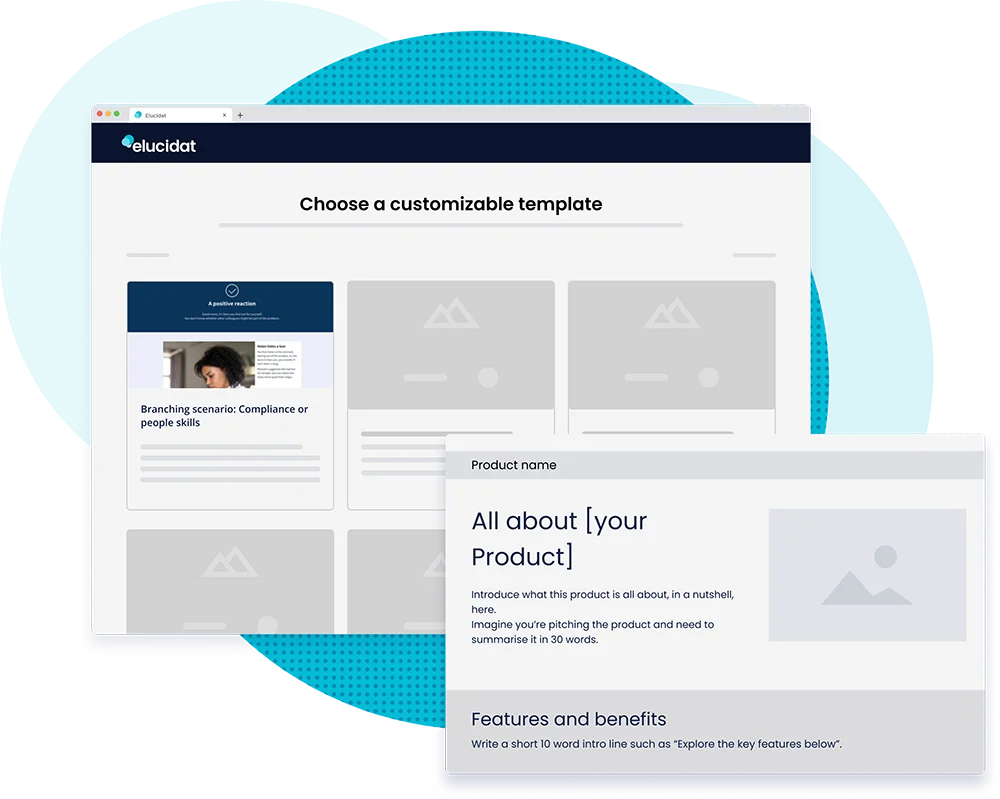Introduction
In today’s evolving business landscape, the critical skills required for success are no longer a static target. Meeting changing business needs at speed and scale requires new collaborative and agile ways of working. While learning teams have always worked with SMEs, more and more L&D teams are getting in-house experts involved in content production.
“We have a lot of authors of online learning content that don’t sit in L&D. They’re the experts in their field. We empower these Subject Matter Experts to create elearning themselves.’’
Whilst on paper bringing in subject matter experts (SMEs) to create learning content makes a lot of sense, it can be challenging to get right.
We held roundtable discussions with L&D leaders from various industries, who are embracing SME authoring, to investigate what it takes to be successful. From their comments, it’s clear that establishing author communities requires planning, process, collaboration, and an adaptive mindset. But it’s entirely possible to do it successfully and get great results.
This guide shares the tips, ideas and models used by multiple Elucidat customers as they’ve embarked on this journey. Hear what lessons they’ve learnt, and borrow ideas that will help you step up to a collaborative authoring model effectively and benefit from the added elearning capacity it brings.




Why set up an SME authoring community?
The idea of anyone creating digital learning can make even the most forward-thinking L&D professionals feel nervous.
Let’s face it, opening up elearning creation to novice authors and subject matter experts (SMEs) doesn’t necessarily come easy. They aren’t learning experts, after all.
So, why are we seeing more and more L&D teams embrace this model?
Despite working in a range of industries and organizational structures, the L&D leaders we talked to came up with seven clear reasons for taking this approach.

Who can be an author?
It’s clear from these success stories that there are many different ways to set up a successful authoring community. Part of the decision making process is to consider who you have in your organization who could be a successful elearning author; and what projects or skill gaps need to be filled.
Consider who you could bring in to ease the pressure and tackle those most in-need skills. For example:

Trainers
Their experience in face-to-face and virtual classrooms provides vital learner insights.

Compliance officers
They don’t just know the policies. They understand where things have gone wrong and the impact it had.

Skills specialists
Whether it’s technical or soft skills, those with in-house specialist knowledge can ensure learning is relevant.

Marketing teams
Their expertise in writing and storytelling can help make
learning content appeal to specific audience groups.

More experienced teams
If people are already producing learning content across your
organization, involving the most advanced will give you a head start.
What kinds of elearning should novices create?
Different projects require different approaches. List the projects you typically have on the horizon. Think about which projects you feel would be better managed by the L&D team rather than the community. Here’s our expert community’s suggestions.

Produce in your team
Content that aligns with big strategic organizational goals, change initiatives, or your company’s competitive advantages. For example, company values, culture, diversity, equity, inclusion and belonging, leadership strategies.

Produce with SMEs
Content that relies on specific in-house knowledge, for example, product knowledge, process changes, and the latest AI policies, and that lend themselves to templated how-to guides and on-the-job resources.
What are the main challenges?
Of course, when you roll out a completely new elearning production approach, you’re bound to face teething problems.
The L&D managers we talked with discussed several challenges they had to tackle to set up and sustain their communities of authors.
Here are the 3 common challenges.

Top tip:
Don’t rush ahead and get people creating elearning before you’ve nailed a process.
Whether it’s design principles or a governance model, deciding on, testing and refining a workflow upfront makes for a smoother journey to elearning production at scale. Should everyone be able to put content live, for example?
Top tip:
If you’re going to sustain their interest and keep to project timelines, you need to provide your authors with support. This could include onboarding, training, resources and templates with learning design best practice baked in – to name just a few approaches.
It’s all about balance. Offer the right level of support, but avoid overwhelming people.
Top tip:
If consistency is to be maintained, you need to have robust controls in place and establish expectations. This can include creating super admins representing ‘central’ L&D in each business area; establishing a needs analysis process as a kind of ‘triage’; and defining clear authoring tool permissions.
Tools like PowerPoint Import can be a great shortcut in the content creation process, but make sure there’s broader guidelines around how to turn this raw content into truly effective elearning.
How do you set up and sustain a successful authoring community?
Whether starting from scratch or working with well-established authoring communities, the L&D leaders that we talked to had many shared experiences, challenges and successes. Every industry and organization may be different, but all these L&D teams highlighted the same four steps to help keep authoring communities and elearning production on track.

Customer case studies
Our customers shared some specific approaches they have been using to help engage and maintain their communities of elearning authors.
To give you the same ‘ah hah’ moments we had whilst listening, here are six insightful case studies to inspire you. (You can steal these ideas too!).


Adeo: Pilot first
World leaders in home improvement, Adeo may have a central L&D team, but managing digital learning production across 17 countries and in 15 languages isn’t straightforward. Each business unit has a high level of autonomy (but also interdependency) with different needs and levels of maturity and experience in terms of content creation.
Rather than roll out a new approach across the company we have decided, on the one hand, to create a community of learning experts called Share & Learn that helps us align strategies, processes and methodologies and, on the other hand, pilot groups with business units who are more mature in some aspect of the digital content creation process.

“Pilot groups help us test hypotheses, test new functionalities, products or processes and innovate at greater speed. One of the problems we have is that maturity, in terms of content creation, from one unit to another it is really different. In some business units, for example, we have an L&D team that externalizes the content process creation, while some other business units internalize that production of content.
So, these pilot groups help us define aspects such as, for example, the definition of the roles involved in content creation, workflows, processes for integrating novice authors. And, in fact, we have identified some interesting and promising aspects.”
– Juan Luis Vicente Bueno, Business Product Leader, Adeo

Oxfam: Bring in local governance
With 9,000 employees across 87 countries, Oxfam is a global charity that needs to move quickly to support partners, people on the ground, and communities in need. Rather than slow the process down with centralized checks, Jo Grantham, Training Lead, has established representatives in each area of the organization. They act as the local go-to person for any novice author, setting standards and filtering queries. Like a triage.
Want to find out more? Explore this L&D approach in Oxfam’s story.
“So, we’ve tried to put a ‘middle man’ between the core team and the end user or author.
In each of our categories, we’ve now got a category owner who sits in the business. Now they may not necessarily be a power Elucidat player, but they’re the person between us and the author.
So, when any author wants a license, the first port of call is to go to the category manager and say, ‘Hey, I want to develop this course on feminist principles’.
The category manager asks: What’s it going to look like? What material is it going to contain? Who’s the target audience? And so, there’s a buffer before these people even get a license. And then that’s our single point of contact for each category. Rather than have the contact directly with the authors, let’s try and shift some of that governance or checks and balances out.”
– Jo Grantham, Training Lead, Oxfam

nCino: Use expert-created templates
A global leader in cloud banking, nCino has over 1,200 employees worldwide. Like many businesses, the more elearning nCino produces, the more the company wants it. To meet demand, nCino opened up elearning production to SMEs. Olivia Cunningham, Instructional Designer, ensured that novice authors were supported in creating effective learning by setting up templates that contained clear guidance. The benefit? She got time back to work on strategic projects.
Want to find out more? Explore the full story in nCino’s customer spotlight.

“I created templates, that aligned with the nCino brand and what our other courses look like, but also that incorporated instructional design best practices.
I don’t have to handhold and be there for every step of the process. [This approach] allowed me to focus on some of the bigger projects and some of that design and consultation work that takes a lot of time.”
– Olivia Cunningham, Instructional Designer, nCino

Domestic & General: Create champions
Domestic & General is an insurance provider with a relatively small L&D team that supports around 3,000 employees. With an increasing demand for digital learning, they needed a new collaborative approach to delivering the business’ learning needs. So, Jonathan Holmes, Digital Learning and Strategy Manager, implemented a smart partnership model.
Rather than seeking any subject expert in the organization to take on a learning project, his team started by focusing on finding their SME champions. These are motivated subject experts with some background in professional training. They enabled the L&D team to gain traction before branching out more widely to bring in other experts from the business.
- Start with those who ‘get’ learning e.g. trainers; and build digital learning champions
- Move to bring in those with clear communication or media skills e.g. marketing team SMEs
- Finally, bring in other subject experts but only once you have established champions and a working process.
Learn more about this partnership model in our webinar with Jonathan from Domestic & General.

“One of the ideas was to essentially build a community of people from all parts of the business that we’re able to either create or co-create solutions with us and effectively start to remove ourselves from being a blocker.”
– Jonathan Holmes, Digital Learning and Strategy Manager, Domestic & General
Global drinks brand: Provide an ‘intro to learning’ design program
With 85 operating companies, more than 300 brands, and 90,000 staff members, a multinational brewing company has L&D responsibility spread across the business. Working at this scale, the central L&D team can only have so much influence. For Geraldine Murphy, Global Learning Experience Manager, that has meant focusing on frameworks and governance to set her community of authors up for success.
Geraldine worked with Elucidat’s Learning Consultancy team to develop an introduction to learning design program that made sure standards would be met. The smart thing about it? Geraldine took a novel approach and got people to apply for their place. The results? A huge jump in the level of commitment and engagement of participants.

“We designed a program with Elucidat to take people from zero to hero, in a short time.
The people that wanted to be part of the champions program had to really spell out why they wanted to take part in the course. It’s free to them, even though it’s been paid for by a central budget, but they had to say exactly what they were going to do with it. So, we could have some kind of measurement of impact.
And that actually has meant that more people are interested in using the tool because they have the opportunity to get this really short, sharp boot camp upskilling, paid for by central rather than something they have to do by themselves, paid for by themselves. And that’s been really impactful for us.”
– Geraldine Murphy, Global Learning Experience Manager, Global Drinks Brand
Everyone: Community meet ups!
To sustain their SME authoring communities, nearly all of the customers we spoke with held some kind of community meet-ups.
From in-person ‘lunch n learns’, to virtual Slack communities and regular online meet-ups – it’s important to hold space for authors to learn best practice, share experience and showcase their projects to learn from on another. One manager recommended splitting the time between some formal learning that they bring to the session, which can help draw people in, and then an open peer-sharing session to support authors to learn from one another.
“I created a whole Teams channel, and I try to put some messages from time to time, some benchmarks.
And every two months, we meet. Everyone who has been trained at some point on Elucidat, even if they’ve already launched their module or they’re not working yet on it, is part of the community and is invited to sit around the virtual table of our meetings.”
– Digital Learning Project Manager, Luxury Retail Brand
In summary
To scale up elearning production and stay ahead of training demand, involving in-house experts from across your organization to create elearning is a smart move.
Here’s a recap of what to take forwards.

Getting inexperienced authors onboard, engaged, and producing effective learning needs a little upfront investment.
But you don’t have to do it all in one go. Start small, find your model, and build up.
Soon your effort will pay off: more capacity, faster turnarounds, better results.
- Identify and engage with a smaller group first, to create champions
- Build out processes and governance early on, learning from a pilot
- Offer upfront onboarding and consider short courses in learning design for those who will do multiple projects
- Use regular community share sessions or similar to drive focus and ongoing development
- Provide templates to shortcut SMEs’ learning curves, and uphold consistency
Unlock the power of
your SMEs with Elucidat
Empower your Subject Matter Experts to create engaging and impactful elearning content with Elucidat. Leverage built-in templates, advanced user management, and an intuitive authoring interface.
Plus, get a head start with PowerPoint import and AI-driven guidance.













